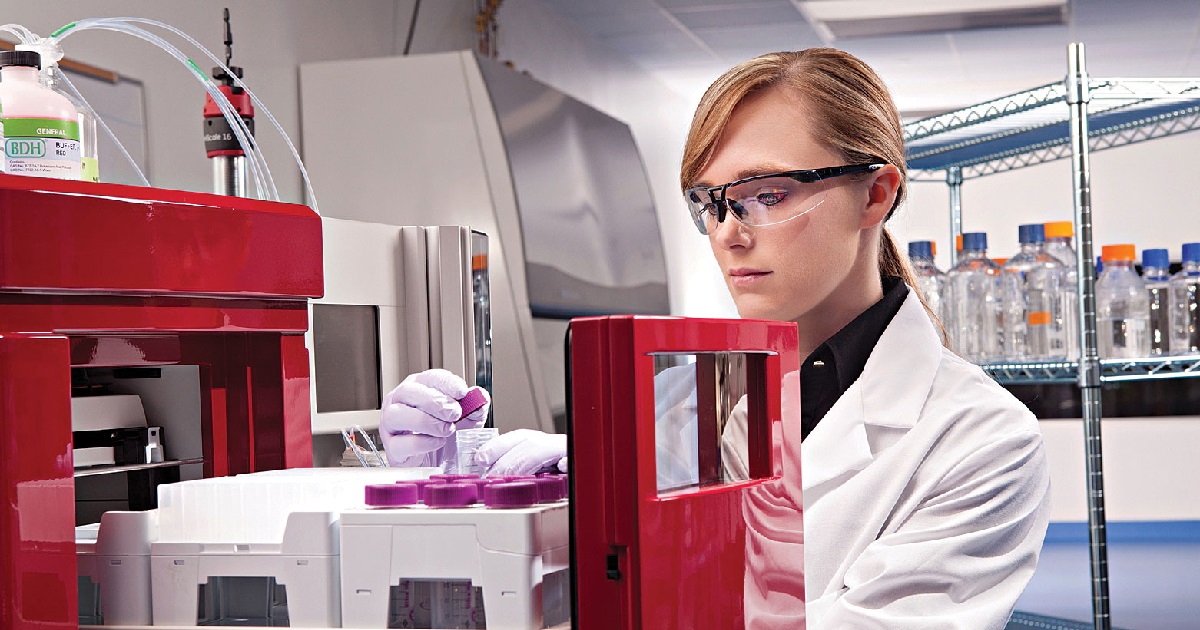
MedTech
Article | July 12, 2022
If you have ever visited the testing laboratory of a large biotechnology company, you will be aware that managing the laboratory's operations single-handedly is no easy task. The greater the size of a lab, the more research and testing activities it must accommodate.
A variety of diagnostic tests are prescribed for patients in order to detect various diseases. For example, it may include blood glucose testing for diabetics, lipid panel, or liver panel tests for evaluating cardiac risk and liver function, cultures for diagnosing infections, thyroid function tests, and others.
Laboratory management solutions such as laboratory information management systems (LIMS) and other software play a significant role in managing various operational data at biotech laboratories. It is one of the important types of software developed to address thedata management and regulatory challenges of laboratories. The software enhances the operational efficiency of biotech labs by streamlining workflows, proper record-keeping, and eradicating the need for manually maintaining data.
What Are the Benefits of Laboratory Information Management Software in Biotechnology?
As the trends of digitization and technology continue to create deeper inroads into the biotechnology sector, a significant rise in the adoption of innovative medical software solutions, such as LIMS, is being witnessed for managing research data, testing reports, and post-research results globally. Here are a few reasons that are encouraging biotech facilities to adopt LIMS solutions
Real-Time Data Collection and Tracking
Previously, collecting and transporting samples was a tedious and time-consuming task. However, the adoption of LIMS with innovative tracking modules has made the job easier. The real-time sample tracking feature of LIMS has made it possible for personnel to collect the research data in real-time and manage and control the workflow with a few mouse clicks on the screen.
Increase Revenue
LIMS makes it possible to test workflows while giving users complete control over the testing process. A laboratory is able to collect data, schedule equipment maintenance or upgrades, enhance operational efficiency, and maintain a lower overhead with the help of the LIMS, thereby increasing revenue.
Streamlined Workflow
With its completion monitoring, LIMS speeds up laboratory workflows and keeps track of information. It assigns tasks to the specialist along with keeping a real-time track of the status and completion of each task. LIMS is integrated into the laboratory using lab information, which ultimately speeds up internal processes and streamlines the workflow.
Automatic Data Exchange
LIMS solutions store data in a centralized database. Automated transfer of data between departments and organizations is one of the major features of LIMS. Through its automated information exchange feature, LIMS improves internal operations, decreases the reporting time for data sharing, and assists in faster decision-making.
Final Thoughts
As the healthcare sector continues to ride the wave of digital transformation, biotech laboratories are emphasizing adopting newer technologies to keep up with the changes.
Citing this trend, laboratory information management systems are becoming crucial for biotech and medical organizations for maintaining research data, instant reporting, and managing confidential, inventory, and financial data with centralized data storage.
Read More

MedTech
Article | July 13, 2022
Introduction
The medical and life-science industries are experiencing a robust transformation with the increasing prevalence of various types of diseases, including infectious diseases, chronic disorders, and acute conditions around the world. As a result, a significant rise in demand for more effective therapeutic drugs and bionics is being witnessed, leading to a swift increase in the number of clinical trials.
For a successful trial, it is important for biotech companies to ensure the data submitted to regulatory bodies regarding clinical trials is accurate, reliable, and definitive from an ethical point of view. A reliable clinical trial management system plays a vital role in collecting, monitoring, and managing clinical data. The availability of high-quality clinical data also helps clinical research institutions make efficient treatment decisions and provide proper patient care.
Hence, a number of biotech companies and research organizations are focusing on leveraging innovative clinical trial management solutions to handle a large amount of data, particularly in multi-center trials, and generate reliable, high-quality, and statistically sound data from clinical trials. However, selecting the most appropriate and reliable clinical trial management system is vital for the clinical trial's success. Let's see some of the steps that will assist these firms in choosing the right CTMS.
Key Steps for Selecting Right Biotech Clinical Trial Management System
Prioritize Study Needs
Considering and prioritizing study needs is a crucial step in choosing the most reliable clinical trial management system for biotech companies. Prioritizing helps them to identify a solution that improves the study's quality and removes uncertainty for researchers when faced with difficult choices.
Hence, biotech and life-science organizations should choose a clinical trial system that is simple to use, well-organized, and suitably designed to minimize the number of clicks required to complete a task.
Select CTMS with Multiple Integrations
Integrated clinical trial management systems provide the best value for the companies’ funds as they guarantee the smooth functioning of research protocols. In addition, integrations are necessary to fully understand the importance and advantages of clinical trial management software for ensuring smooth transitions between site management and data collection.
Biotech and clinical research should look for CTMS platforms that can integrate with electronic medical record (EMR) platforms and clinical research process content (CRPC) billing grids. This will allow them to use the same billing designations and ensure compliance while minimizing the need for duplicate processes.
Ensure System Compliance and Security
Clinical research organizations need to adhere to a plethora of complex regulations in order to ensure compliance with one of the most challenging environments of principles, which is information security and privacy. Security and system compliance are vital aspects of choosing the right CTMS solutions for biotech firms as they assist in building trust and form a part of the system’s duties.
While selecting CTMS systems, it is essential for companies engaged in clinical research to ensure that these platforms are able to configure both, group and individual permissions, along with having a data backup and recovery plan for hosted systems. This will allow companies to assess the privacy and security implications of research and anticipate complications that may arise in each phase of the project.
Assess the Scalability
Choosing a scalable CTMS that can accommodate various types of fluctuations and expansions enables biotech and clinical firms to quickly adapt to fast-changing trends and demand spikes while reducing maintenance costs and enhancing user agility.
As scalability also means secure and expanded data storage, these businesses should instead use SaaS solutions than manually manage an ever-growing collection of hard drives. The right CTMS ensures accommodating the firm’s availability requirements without incurring the capital costs associated with expanding a physical infrastructure.
The Closing Thought
A well-executed and successful clinical trial involves multiple stages and processes. Several quality controls and stringent adherence to regulations are essential for the steps, along with efficient cross-departmental processes and procedures. Incorporating the right CTMS paves the way for paperless data collection, regulatory filing, and fiscal management tools for biotech researchers and administrative personnel.
Read More

Research
Article | July 11, 2022
Natural remedies have been employed in medicine since antiquity. However, a large number of them fail to go past the clinical trial stages. In vivo instability, poor solubility and bioavailability, a lack of target-specific delivery, poor absorption, and side effects of the medication are only a few of the problems caused by the use of large-sized materials in drug administration.
Therefore, adopting novel drug delivery systems with targeted medications may be a solution to address these pressing problems. Nanotechnology has received tremendous attention in recent years and has been demonstrated to help blur the boundaries between the biological and physical sciences. With great success, it plays a vital part in enhanced medication formulations, targeted venues, and controlled drug release and delivery.
Limitations of Traditional Delivery Trigger the Adoption of Nanoparticles
The field of nanotechnology and the creation of drug formulations based on nanoparticles is one that is expanding and showcasing great potential. It has been thoroughly researched in an effort to develop new methods of diagnosis and treatment and to overcome the limitations of several diseases' current therapies. As a result, nanoparticles are being used to improve the therapeutic effectiveness and boost patient adherence to treatment by increasing medication bioavailability, drug accumulation at a particular spot, and reducing drug adverse effects.
The nanoparticles could be transformed into intelligent systems housing therapeutic and imaging agents by manipulating their surface properties, size, correct drug load, and release with targeted drug delivery.
Nanostructures facilitate the release of combination medications at the prescribed dose since they remain in the blood circulation system for a long time. Therefore, they result in fewer plasma fluctuations with decreased side effects. Due to their nanoscale, these structures can easily enter the tissue system, promote the absorption of drugs by cells, make medication administration more effective, and ensure that the medicine acts at the targeted location.
The Way Ahead
Nanomedicine and nano-delivery systems are a comparatively new but fast-evolving science in which nanoscale materials are used as diagnostic tools to deliver drug molecules at precisely targeted sites in a controlled manner. It is finding applications for the treatment of diseases such as cardiovascular, neurodegenerative, cancer, ocular, AIDS, and diabetes, among others. With more research and technological advancement, these drug delivery solutions will open up huge opportunities for companies that work with them.
Read More

Medical
Article | August 2, 2021
In the downstream portion of any bioprocess, one must pick through the dross before one can seize the gold the biotherapeutic that the bioprocess was always meant to generate. Unfortunately, the dross is both voluminous and various. And the biotherapeutic gold, unlike real gold, is corruptible. That is, it can suffer structural damage and activity loss. When discarding the dross and collecting the gold, bioprocessors must be efficient and gentle. They must, to the extent possible, eliminate contaminants and organic debris while ensuring that biotherapeutics avoid aggregation-inducing stresses and retain their integrity during purification and recovery. Anything less compromises purity and reduces yield.
To purify and recover biotherapeutics efficiently and gently, bioprocessors must avail themselves of the most appropriate tools and techniques. Here, we talk with several experts about which tools and techniques can help bioprocessors overcome persistent challenges. Some of these experts also touch on new approaches that can help bioprocessors address emerging challenges.
Read More